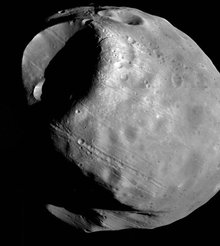Phobos program
|
|
Phobos_taken_by_Phobos-2_spacecraft.jpg
The Phobos program was an unmanned space mission consisting of two probes launched by the Soviet Union to study Mars and its moons Phobos and Deimos.
Phobos 1 and its companion spacecraft Phobos 2 were a new spacecraft design, succeeding the type used in the Venera planetary missions of 1975-1985, including the last used during the Vega 1 and Vega 2 missions to comet Halley. Phobos 1 was launched on July 7, 1988 and Phobos 2 on July 12, 1988, each aboard a Proton-K rocket. They each had a mass of 2600 kg (6220 kg with orbital insertion hardware attached). The objectives of the Phobos missions were to:
- conduct studies of the interplanetary environment;
- perform observations of the Sun;
- characterize the plasma environment in the Martian vicinity;
- conduct surface and atmospheric studies of Mars; and,
- study the surface composition of the Martian satellite Phobos.
The main section of the spacecraft consisted of a pressurized toroidal electronics section, surrounding a modular cylindrical experiment section. Below these were mounted four spherical tanks containing hydrazine for attitude control and, after the main propulsion module was to be jettisoned, orbit adjustment. A total of 28 thrusters (twenty-four 50 N thrusters and four 10 N thrusters) were mounted on the spherical tanks, with additional thrusters mounted on the spacecraft body and solar panels. Attitude was maintained through the use of a three-axis control system, with pointing maintained with Sun and star sensors.
Phobos 1 operated nominally until an expected communications session on 2 September 1988 failed to occur. The failure of controllers to regain contact with the spacecraft was traced to an error in the software uploaded on 29/30 August, which had deactivated the attitude thrusters. By losing its lock on the Sun, the spacecraft could no longer properly orient its solar arrays, thus depleting its batteries.
Phobos 2 operated nominally throughout its cruise and Mars orbital insertion phases, gathering data on the Sun, interplanetary medium, Mars, and Phobos. Shortly before the final phase of the mission, during which the spacecraft was to approach within 50 m of Phobos' surface and release two landers, one a mobile 'hopper', the other a stationary platform, contact with Phobos 2 was lost. The mission ended when the spacecraft signal failed to be successfully reacquired on March 27 1989. The cause of the failure was determined to be a malfunction of the on-board computer.
It is likely that the spacecraft design was immature and technical design issues not fully resolved, problems not uncommon to early generation Soviet space hardware. The Phobos design was used again for the long delayed Mars 96 mission which ended in failure when the launch vehicles fourth stage misfired.
Related articles
References
External Link
- Images from Phobos 2 (http://pages.preferred.com/%7Etedstryk/phobos2.html)de:Fobos

